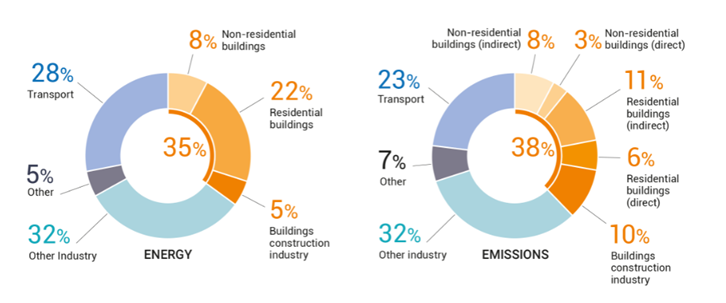How Building Automation Systems (BAS) Can Help Companies Achieve Their Sustainability Goals
Sustainability in the construction industry is achievable through Building Automation Systems. Through this blog, let’s explore how.
Today’s commercial buildings account for ~55 percent (DOE report) of total global electricity consumption and ~40 percent of global energy-related CO2 emissions. With increased focus on and binding CO2 emission targets over the last decade, almost every major company in the building domain now has an ambitious sustainability target of net-zero carbon emission to be achieved between 2030 and 2050. Reducing energy consumption in commercial buildings is a key area that companies are focusing on to achieve sustainability targets.

12020 United Nation’s Global Status Report for Buildings and Construction
The US Department of Energy estimates that around 40 percent of energy consumption in commercial buildings is attributed to heating, ventilation, and air conditioning (HVAC) systems. If we broaden the scope a little and include building lighting systems, then the total energy consumption increases to about 51 percent. If only there were a solution that would reduce the energy consumption for HVAC and lighting systems by half, it would result in ~20 to 35 percent savings in energy costs for commercial buildings (or roughly $1 per sq. ft. of savings)!
In fact, a quick remedy to this problem already exists in the market—an integrated Building Automation System (BAS). A BAS system can produce energy savings by
- running equipment only when necessary
- operating the equipment at minimum capacity, and
- minimizing the peak electricity demand
The problem is not that the industry is unaware of efficiency gains from implementing BAS; it is the low adoption rates for BAS—currently, only 42 percent of the total US commercial floor space is served by a BAS. Despite the promising energy efficiency benefits of these systems, half of all buildings over 100,000 sq. ft. are not equipped with one. Buildings smaller than 50,000 sq. ft., even with their complex energy management challenges and significant energy efficiency potential, are rarely fitted with a BAS.
Factors driving a low BAS adoption rate
Studies indicate that the two key factors behind such low BAS adoptions rates are:
- High implementation cost
- Each BAS system for a building is a bespoke implementation
The physical cost of such systems is roughly 10 to 20 percent of the total cost—installation, software programming, and maintenance account for the remaining cost. Generally, the implementation cost ranges from $1.5/sq. ft. to $7/sq. ft., depending on the building type. This high implementation cost of BAS is the primary driver for its low rate of adoption.
During a typical BAS installation and commissioning phase, associations among the sensors, actuators, and their controls, between application-specific controllers and their supervisory controllers, and between peer controllers are done manually. This manual process is often prone to error and, in the absence of any industry-adopted naming standards, becomes subjective to the degree of knowledge the person installing the system has. This means the building metadata is encoded within point names in a variety of different ways, which makes it difficult to interpret and automate. It means manual intervention is required for point mapping—resulting in high implementation costs.
For a BAS system to become ubiquitous, these implementation costs will have to drop considerably, and one way of achieving it is by automating BAS implementation either partially or fully.
How BAS implementations can be ported automatically
There are two possible approaches to this:
- All BAS systems must use the same point naming conventions (standard ontology)
- Point names in a building must be mapped automatically (automated point mapping)
A standard ontology for point names across Building Automation System applications can make building metadata easily readable by machines. There have been multiple efforts in the area of standardizing naming conventions such as Haystack, IFC, ISO 16484-3:2005, and the current industry favorite, Brick Schema. However, none of these is as yet widely adopted. Reasons for their low adoption vary, including:
- These standards do not represent all the metadata required in a building application.
- No laws or regulations mandating the use of standardized point name schemas.
- The average lifespan of a building, depending on the type of construction material (steel, wood, concrete, etc.), is anywhere between 51 to 87 years. Of the total 5.5 million commercial buildings in the US, 4.5 million (81 percent) were constructed before the dawn of the new millennium.
Further, 25 percent of the commercial buildings that were constructed before the 1950s are still operational. During this time, buildings went through multiple cycles of renovation. However, only in a few of these are the BMS systems or the labels ever tinkered with.
Automating the process of acquiring the metadata directly from point labels can automate the understanding of the physical, logical, and functional structure of a building. This can be done by using ML-trained algorithms or different methods based on point names or the time series-based information generated by various points.
Over the past decade, multiple studies have been conducted on automatic label extraction, and they all have faced three main problems in the area of automated point mapping:
- Identifying the point type automatically.
- Identifying the spatial context between the sensors and building spaces.
- Discovering the functional relationship between HVAC components cannot be done automatically without context.
As things stand, it appears there is no clear solution to the low BAS adoption rate. However, with recent advancements in the area of standard ontology, automated point mapping, and cross-manufacturer collaborations, it seems a solution is on the anvil—just not fully insight.
We envision an ideal solution that will leverage machine learning and NLP-based pattern recognition for automated point-type classification and empirical mode decomposition-based implementation for spatial relationships. It is just a matter of time and a few more iterations before the industry’s current woes become history.
Reference:
Report ‘2020 United Nation’s Global Status Report for Buildings and Construction’*
More from Girish Meena
It would have been unimaginable for our foraging nomad ancestors to believe that their offspring…
Latest Blogs
A closer look at Kimi K2 Thinking, an open agentic model that pushes autonomy, security, and…
We live in an era where data drives every strategic shift, fuels every decision, and informs…
The Evolution of Third-Party Risk: When Trust Meets Technology Not long ago, third-party risk…
Today, media and entertainment are changing quickly. The combination of artificial intelligence,…




